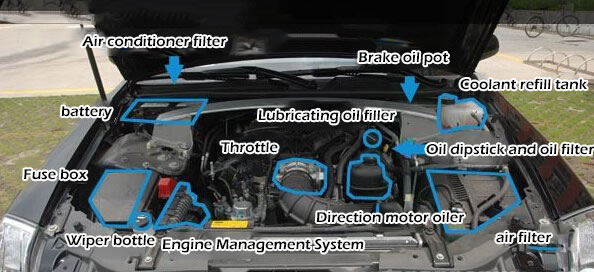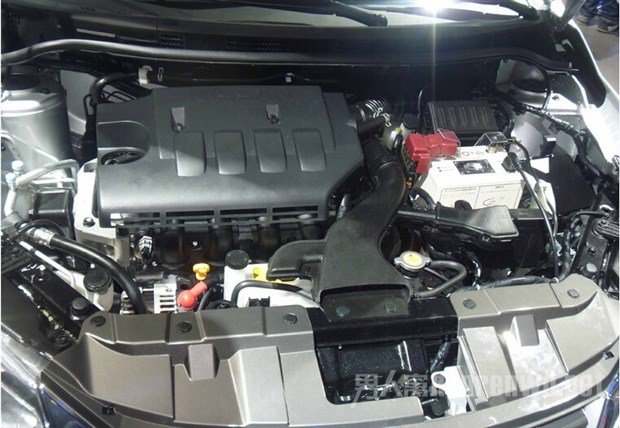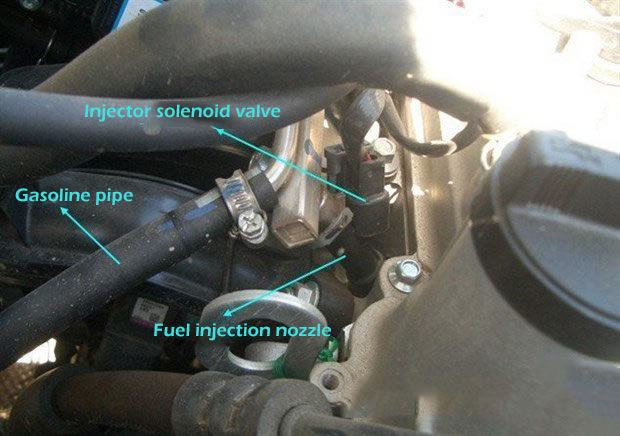
Open the engine cover, this is the HR16DE engine.
Air filter: The function is to filter dust and impurities in the air and let clean air enter the engine, which is very important for the life and normal operation of the engine. The dust and impurities adsorbed by the air filter will be blocked if there are too many, which will affect the engine operation, so it must be replaced regularly. If driving in a dusty place, such as where there is a sandstorm, the air filter replacement cycle will be shortened.
Battery: Needless to say, it stores electrical energy. Lead batteries are generally used, and the electrolyte is dilute sulfuric acid.
Brake fluid: Now the brakes of cars are generally hydraulic, that is, the brake fluid is used as a medium to transmit the force of the brake pedal to the brake disc.
Ignition coil: converts low voltage to high voltage, sparks are generated by the discharge of the spark plug below it, and the oil-air mixture is ignited to do work.
Motor oil: mineral oil or synthetic oil that acts as a lubricant and seal. If the engine lacks lubricating oil, it will cause serious problems such as cylinder pulling.
Power steering oil: The steering power of the car is generally still the traditional hydraulic power. Since it is hydraulic, the oil medium is needed. Of course, some cars have begun to use electric power, which is also the future development trend.
Antifreeze: circulating in the channels of the radiator and the engine cylinder, the liquid medium used to cool the engine, mainly water and additives, because of the antifreeze function, it is called antifreeze.
Glass water: Everyone on earth knows that it is used to wipe glass.
Oil dipstick: a ruler to detect the amount of oil. When using the engine, first turn off the engine, pull out the oil dipstick, wipe the oil with a clean paper towel, and then insert and then pull out, see the oil level of the oil, must be between the two upper and lower limits on the ruler, no more Not less.
Fuse box: There are many fuses for electrical equipment and relays. For details, please refer to the instruction manual.
Air inlet: the inlet of the engine air inlet. The location of the air inlet is the limit of the wading depth of the car, and it must not be exceeded. Once the engine enters the water, the consequences are serious.

Electronic throttle: It connects the intake manifold and the intake manifold, which controls the engine air intake. The engine control module calculates the fuel injection quantity based on the intake air quantity, so that the engine speed and output power can be controlled. There is also a cable throttle, which uses a cable to control the throttle opening. Although the power does not directly lag the electronic throttle, the electronic throttle has a high technology content and saves fuel.
Intake manifold: The intake manifold that branches from the intake manifold to each cylinder.
Carbon canister valve: The carbon canister absorbs the gasoline vapor in the fuel tank. After the carbon canister valve is opened, the gasoline vapor adsorbed by the activated carbon in the carbon canister of the engine is sucked into the intake pipe, and finally participates in the combustion. This is not only beneficial to environmental protection, but also saves a little oil.
Gasoline distributor: It distributes gasoline to each fuel injection nozzle. The fuel injection nozzle is connected below it, which is blocked and cannot be seen.
Crankcase ventilation pipe: the right side is the intake pipe, and the left side is the exhaust pipe, which is used to ventilate the crankcase.
Detailed explanation: When the engine is working, part of the combustible mixture and exhaust gas will pass through the piston ring into the crankcase. After the gasoline vapor condenses into the crankcase, the oil will become thinner and the performance will deteriorate. The water vapor and sulfur dioxide in the exhaust gas condense in the engine oil to form foam and destroy the oil replenishment. This phenomenon is especially serious in winter; sulfur dioxide meets water to generate sulfurous acid, and sulfurous acid encounters oxygen in the air to generate sulfuric acid. These acidic substances The emergence of oil will no longer cause oil to flow into the crankcase from combustible mixture and exhaust gas, the pressure in the crankcase will increase, and the oil will leak out from the crankshaft oil seal, crankcase gasket, etc. and be lost. The loss to the engine cylinder crankcase ventilation device can avoid or replace the above phenomenon. Therefore, the role of the engine cylinder box ventilation device is: 1. Prevent deterioration of engine oil; 2. Prevent leakage of crankshaft oil seal and crankcase gasket; 3. Prevent various oil vapors from polluting the atmosphere. Crankcase ventilation includes natural ventilation and forced ventilation. Modern gasoline engines often use forced crankcase ventilation, also known as PCV system. When the engine is operating, the intake pipe vacuum draws fresh air through the air filter, the air hose enters the cylinder head cover, and then enters the crankcase through the cylinder head and the holes in the body. Fresh air in the crankcase is mixed with cylinder box gas, then enters the intake pipe through the cylinder head cover, and the crankcase gas hose, and finally burns into the combustion chamber through the intake valve.

Fuel injection nozzle: spray the gasoline after pressurized by the gasoline pump in the form of atomization. The hole of the fuel injection nozzle is very small, so as to better atomize the gasoline, but at the same time it is also easy to block, so the fuel injection nozzle should be cleaned regularly. At present, the engine of a car is generally electronically injected. The so-called electronic injection is short for electronically controlled fuel injection. The basic principle is that the engine control module calculates the best fuel injection timing and fuel injection amount based on the information of each sensor, controls the fuel injection nozzle, injects gasoline to the end of the intake manifold, and then is sucked into the cylinder by the engine to burn and do work. Different from the traditional carburetor engine, the EFI engine can control the fuel quantity more accurately, the atomization is good, and the combustion is full. It brings excellent performance. My space information is updated daily, and it can save fuel. However, the advanced technology also has shortcomings, it is too complicated, and maintenance is not easy.
The above is the illustration of the car hood parts organized by the editors for the drivers and friends. I hope it can help you and understand the car engine in depth!
Want to know more HHO Carbon Cleaner?
Email: sales@carboncleaningmachine.com
WhatsApp:+86 153 6403 5493
Wechat :+86 153 6403 5493